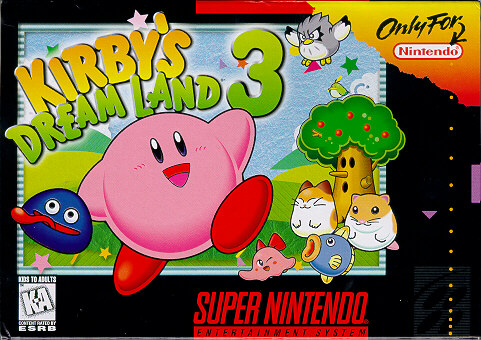Kirby vs. Darkness Review
Gallery

Kirby has always been a personal favorite Nintendo character of mine. As an adorable pink puff ball that sucks his enemies up like a vacuum and absorbs their powers, Kirby gives a new meaning to “you are what you eat.” With so many games to choose from I decided to review a trio of titles that is unofficially known as “The Dark Matter Trilogy” among fans.
Each of the three games share a similar story: Dark Matter, an ominous mind controlling black shadow, has a fondness for terrorizing the populace of Kirby’s home planet (and other planets as well). Not fond of Dark Matter’s penchant for destruction, Kirby decides to do something about it. That’s all you really need to know.
Kirby’s Dreamland 2 was released for Game Boy in 1995. As a platformer it’s the usual protocol: explore levels, defeat enemies, avoid obstacles, find collectibles, battle mini bosses and fight even bigger bosses at the end of each world. Kirby’s trademark ability of devouring eatable enemies for their powers is the core gameplay mechanic for combat. Seven unique abilities are available for you to absorb: Burning, Ice, Stone, Spark, Needle, Cutter, and Parasol. Parasol, oddly enough, gives you ability to swing an open umbrella like a club.
Another unique aspect is the three animal friends you can ride: Rick the Hamster, Coo the Owl and Kine the Fish. Each animal has its own self-contained abilities (Coo can fly, Kine can swim, etc), but having an absorbed power while riding them will lead to a unique variant of that respective attack. There are many combinations one can experiment with on each animal.
Dreamland 2 started an interesting gimmick that spans the entire trilogy. If you play to the end of the game and beat the regular final boss, the game ends. However, in order to confront Dark Matter, you are required to collect a number of a certain item. In this game you need to find Rainbow Tears and there is just one hidden in each world, though some are tough to find. This is not required to play through and enjoy the game; but it’s the only way to confront the true antagonist and get the best ending.
Kirby’s Dreamland 3 was released for SNES in 1997. The gameplay is very similar to its predecessor. The same seven powers return though an eighth power, named clean, which was added (exclusive to this game). This unusual ability gives Kirby a broom that he can sweep at his enemies.
There are the same animal friends from the previous entry with three more added: Pitch the bird, Nago the cat and Chuchcu the octopus. Another character added is Gooey, a blue blob that can either be summoned to follow and assist Kirby directly (at the cost of health) or a second player can control him (with similar abilities like Kirby).
The extra collectibles in this game are Heart Stars, with one per level this time around complete with a clever self-contained puzzle that guards the item. Some of these puzzles will take some real trial and error to solve, making this entry the toughest for finding everything.
Graphically Dreamland 3 takes on an interesting visual style that is a mix between crayon coloring and oil pastel shading, which is not much different from Yoshi’s Island. This game’s only sin is that it feels too similar to Dreamland 2, which isn’t the worst thing. I just wish people would quit unfairly comparing it to Kirby Super Star.
Kirby 64: The Crystal Shards was released for the Nintendo 64 in 2000. As per usual the gameplay is similar to the previous two entries but has the most differences. The same powers return with the exception of parasol, which has been replaced with bombs (the art of throwing explosives). The animal friends have been completely eliminated and are replaced with a power combination system, allowing you to mix any two powers together and create a unique attack. This is done by sucking up two enemies at once or spitting a power star into an enemy and then devouring both of them. Though this system is simpler than the first two games, experimentation is much easier and more accessible.
The collectibles in this game are the Crystal Shards. There are several hidden in every level now; many will require a certain power combination to get to it and some have more complex methods for finding them.
Visually, this game is easily one of the best looking titles on the N64. No two levels look the same and while it retains its 2D roots, the camera angle often flirts with different perspectives, creating a 2.5D or pseudo 3D effect. While Kirby games have always had solid soundtracks this one takes the cake. Do you need proof? Then go onto YouTube and look up this games soundtrack and give “Quiet Forest” or “Rock Star Theme” a listen. This game might be my favorite in the series but it also is the most flawed. This game is really short, is often too easy, and has underwhelming mini bosses (regular bosses are still solid). Although with it getting everything else right, its issues are easily forgivable.
These are some of the best games to get newly acquainted with Kirby if one hasn’t already. With solid gameplay and enough collectibles to satisfy, you have another set of classics on your hands.
Grade:
The whole series: B-
